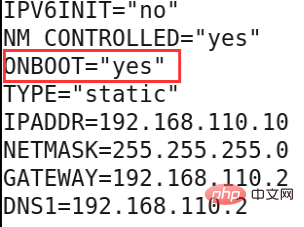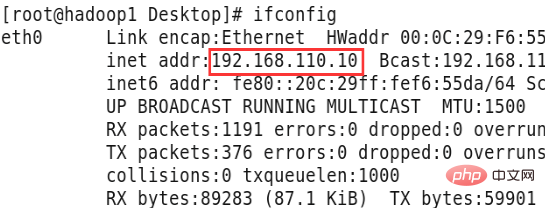 Operation and Maintenance
Operation and Maintenance
 CentOS
CentOS
 The eth0 network card cannot be started automatically under centos6.5
The eth0 network card cannot be started automatically under centos6.5
The eth0 network card cannot be started automatically under centos6.5

Problem:
The eth0 network card cannot be started automatically under Centos6.5. Query the IP address and find that there is no network card eth0.
Troubleshooting process:
Check the ifcfg-eth0 file, ONBOOT="yes", set the network card self-starting method

(Recommended tutorial: centos tutorial)
It may be that the NetworkManager service conflicts with the network.
Close the NetworkManager service and start it automatically. The command is as follows:

Restart the network service and query the ip again


Recommended related video tutorials: linux video tutorial
The above is the detailed content of The eth0 network card cannot be started automatically under centos6.5. For more information, please follow other related articles on the PHP Chinese website!

Hot AI Tools

Undresser.AI Undress
AI-powered app for creating realistic nude photos

AI Clothes Remover
Online AI tool for removing clothes from photos.

Undress AI Tool
Undress images for free

Clothoff.io
AI clothes remover

Video Face Swap
Swap faces in any video effortlessly with our completely free AI face swap tool!

Hot Article

Hot Tools

Notepad++7.3.1
Easy-to-use and free code editor

SublimeText3 Chinese version
Chinese version, very easy to use

Zend Studio 13.0.1
Powerful PHP integrated development environment

Dreamweaver CS6
Visual web development tools

SublimeText3 Mac version
God-level code editing software (SublimeText3)

Hot Topics
 1672
1672
 14
14
 1428
1428
 52
52
 1332
1332
 25
25
 1277
1277
 29
29
 1257
1257
 24
24
 CentOS: What Led to the Decision to End Support
Apr 23, 2025 am 12:10 AM
CentOS: What Led to the Decision to End Support
Apr 23, 2025 am 12:10 AM
RedHatendedsupportforCentOStoshifttowardsacommerciallyfocusedmodelwithCentOSStream.1)CentOStransitionedtoCentOSStreamforRHELdevelopment.2)ThisencourageduserstomovetoRHEL.3)AlternativeslikeAlmaLinux,RockyLinux,andOracleLinuxemergedasreplacements.
 CentOS in Action: Server Management and Web Hosting
Apr 18, 2025 am 12:09 AM
CentOS in Action: Server Management and Web Hosting
Apr 18, 2025 am 12:09 AM
CentOS is widely used in server management and web hosting. Specific methods include: 1) using yum and systemctl to manage the server, 2) install and configure Nginx for web hosting, 3) use top and mpstat to optimize performance, 4) correctly configure the firewall and manage disk space to avoid common problems.
 CentOS: Security, Stability, and Performance
Apr 21, 2025 am 12:11 AM
CentOS: Security, Stability, and Performance
Apr 21, 2025 am 12:11 AM
CentOS is the first choice for server and enterprise environments for its superior security, stability and performance. 1) Security provides forced access control through SELinux to improve system security. 2) Stability is supported by the LTS version for up to 10 years to ensure the stability of the system. 3) Performance significantly improves system response speed and resource utilization by optimizing kernel and system configuration.
 CentOS: Exploring the Alternatives
Apr 15, 2025 am 12:03 AM
CentOS: Exploring the Alternatives
Apr 15, 2025 am 12:03 AM
Alternatives to CentOS include UbuntuServer, Debian, Fedora, RockyLinux, and AlmaLinux. 1) UbuntuServer is suitable for basic operations, such as updating software packages and configuring the network. 2) Debian is suitable for advanced usage, such as using LXC to manage containers. 3) RockyLinux can optimize performance by adjusting kernel parameters.
 CentOS: An Introduction to the Linux Distribution
Apr 19, 2025 am 12:07 AM
CentOS: An Introduction to the Linux Distribution
Apr 19, 2025 am 12:07 AM
CentOS is an open source distribution based on RedHatEnterpriseLinux, focusing on stability and long-term support, suitable for a variety of server environments. 1. The design philosophy of CentOS is stable and suitable for web, database and application servers. 2. Use YUM as the package manager to release security updates regularly. 3. Simple installation, you can build a web server with a few commands. 4. Advanced features include enhanced security using SELinux. 5. Frequently asked questions such as network configuration and software dependencies can be debugged through nmcli and yumdeplist commands. 6. Performance optimization suggestions include tuning kernel parameters and using a lightweight web server.
 The End of CentOS: Evaluating the Impact
Apr 26, 2025 am 12:03 AM
The End of CentOS: Evaluating the Impact
Apr 26, 2025 am 12:03 AM
The end of CentOS has had a significant impact on users, with users having the option of RHEL, AlmaLinux, Debian or Ubuntu as alternatives. 1. The migration cost is high, requiring time and money. 2. Community division affects open source projects. 3.RHEL provides commercial support, but it is costly. 4.AlmaLinux is similar to CentOS and has low migration costs. 5. Debian and Ubuntu need more time to adapt.
 Replacing CentOS: Identifying Suitable Replacements
Apr 27, 2025 am 12:04 AM
Replacing CentOS: Identifying Suitable Replacements
Apr 27, 2025 am 12:04 AM
CentOS needs alternatives because CentOSStream no longer provides long-term support. Alternative options include: 1. RockyLinux, which provides 10 years of life cycle support, suitable for users who need stability. 2.AlmaLinux also provides 10 years of support and has strong community support. 3. OracleLinux, provides RHEL-compatible version, and flexible life cycle management.
 CentOS's Departure: Choosing the Right Alternative
Apr 29, 2025 am 12:04 AM
CentOS's Departure: Choosing the Right Alternative
Apr 29, 2025 am 12:04 AM
Alternatives to CentOS include AlmaLinux, RockyLinux, and OracleLinux. 1.AlmaLinux and RockyLinux rebuild RHEL 1:1, providing high stability and compatibility, suitable for enterprise environments. 2. OracleLinux provides high performance through UEK, suitable for users who are familiar with the Oracle technology stack. 3. When choosing, stability, community support and package management should be considered.



